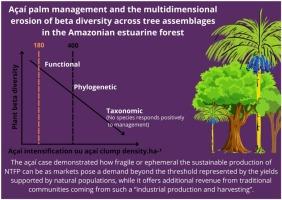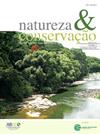Açaí palm management and the multidimensional erosion of beta diversity across tree assemblages in the Amazon estuarine forest
IF 3.5
2区 环境科学与生态学
Q1 BIODIVERSITY CONSERVATION
引用次数: 0
Abstract
Non-timber forest products persist as an opportunity to conciliate tropical forest integrity and better life for traditional communities, but sustainability must be continuously evaluated. This paper examines diversity-related impacts from increments on the açaí palm density for fruit production (i.e., açaí intensification) on the tree assemblages of the Amazon estuarine forest. By examining 43 forest stands covering 20–1260 açaí clump.ha−1, we documented a decline on taxonomic, phylogenetic and functional beta diversity, which resulted from species loss along the intensification gradient. Such an impoverished community assembly resulted from the fact that forest stands with <400 açaí clump.ha−1 exhibited higher scores of species accumulation or beta diversity, while no species responded positively to increments on açaí clump density and 17 species did negatively. The community-level threshold for species loss was 180 clump.ha−1, and after the 400-clumps threshold (as posed by current regulation) almost half of the tree species was already lost. Our results suggest that the açaí intensification represents a driver of tree species assembly and a tangible threat for integrity of the Amazon estuarine forest by promoting a multidimensional community impoverishment at regional scale. Threat magnitude depends on which extension managed, high-density açaí stands replace forest patches supporting açaí natural densities. The açaí case demonstrated how fragile or ephemeral the sustainable production of non-timber forest products can be, since markets pose a demand beyond the threshold represented by the yields supported by natural populations, while it offers additional revenue from traditional communities coming from such a “industrial production and harvesting”.

Açaí亚马逊河口森林棕榈树管理和树木组合中beta多样性的多维侵蚀
非木材林产品仍然是调和热带森林完整性和改善传统社区生活的机会,但必须不断评价可持续性。本文研究了亚马逊河口森林果实生产中açaí棕榈密度的增量(即açaí集约化)对树木组合的多样性相关影响。通过检查43个森林林分,覆盖20-1260个açaí丛。在Ha−1中,我们记录了分类、系统发育和功能β多样性的下降,这是由于物种沿着强化梯度减少造成的。这样一个贫困的社区集会是由于森林中有<;400 açaí树丛。Ha−1表现出较高的物种积累和β多样性得分,而没有物种对açaí丛密度的增加做出积极反应,有17种物种对açaí丛密度的增加做出消极反应。群落水平的物种损失阈值为180簇。Ha−1,在400块阈值之后(根据现行法规),几乎一半的树种已经消失。研究结果表明,açaí强度增强是树种聚集的驱动因素,并通过在区域尺度上促进多维社区贫困化,对亚马逊河口森林的完整性构成切实威胁。威胁程度取决于扩展管理的高密度açaí林分取代支持açaí自然密度的森林斑块。açaí案例表明,非木材林产品的可持续生产是多么脆弱或短暂,因为市场的需求超过了自然人口支持的产量所代表的门槛,而传统社区则从这种“工业生产和采伐”中获得额外收入。
本文章由计算机程序翻译,如有差异,请以英文原文为准。
求助全文
约1分钟内获得全文
求助全文
来源期刊

Perspectives in Ecology and Conservation
Environmental Science-Nature and Landscape Conservation
CiteScore
7.80
自引率
4.30%
发文量
46
审稿时长
59 days
期刊介绍:
Perspectives in Ecology and Conservation (PECON) is a scientific journal devoted to improving theoretical and conceptual aspects of conservation science. It has the main purpose of communicating new research and advances to different actors of society, including researchers, conservationists, practitioners, and policymakers. Perspectives in Ecology and Conservation publishes original papers on biodiversity conservation and restoration, on the main drivers affecting native ecosystems, and on nature’s benefits to people and human wellbeing. This scope includes studies on biodiversity patterns, the effects of habitat loss, fragmentation, biological invasion and climate change on biodiversity, conservation genetics, spatial conservation planning, ecosystem management, ecosystem services, sustainability and resilience of socio-ecological systems, conservation policy, among others.
 求助内容:
求助内容: 应助结果提醒方式:
应助结果提醒方式:


